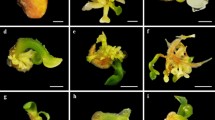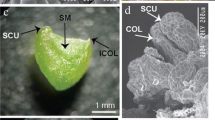Abstract
Indirect somatic embryogenesis (ISE) is required for plant propagation and a prerequisite for applications that may provide new germplasms. Genetic, epigenetic and physiological features of the explant donor are barriers for ISE establishment, hindering its wide use. Despite the identification and/or expression analysis of genes during ISE, no approach to establish the karyotype aspects has been performed so far. So, this study aims to establish the ISE and compare the in vitro responses between diploid (Coffea canephora and Coffea eugenioides), allotriploid (“Híbrido de Timor”—HT) and true allotetraploid (Coffea arabica) Coffea in a taxonomic and evolutive scenario. Under the same in vitro conditions, the four Coffea differed from each other during ISE. Leaf explants of the true allopolyploids yielded the highest mean number of friable calli (FC) in relative short time and visually exhibiting more pronounced length. FC of the allotetraploid C. arabica presented the highest mean number of mature cotyledonary somatic embryos (MCSE), which were also recovered faster in this species. However, MCSE mean number in HT was the same or lower than diploid Coffea. Besides, intraspecific variation related to the ISE responses was observed in each Coffea, mainly the mean number of FC obtained from ex vitro and in vitro C. arabica and C. eugenioides explants. So, epigenetic and physiologic features may also have influenced the ISE responses. The findings provide the basis for performing other approaches considering the ploidy level, epigenetic and physiological backgrounds. Besides, the data also contributed for understanding about the consequences of polyploidy.







Similar content being viewed by others
Abbreviations
- 2,4-D:
-
2,4-Dichlorophenoxyacetic acid
- BAP:
-
6-Benzylaminopurine
- FC:
-
Friable calli
- GA3 :
-
Gibberellic acid
- HT:
-
“Híbrido de Timor”
- ISE:
-
Indirect somatic embryogenesis
- MCSE:
-
Mature cotyledonary somatic embryo
- SC:
-
Secondary constriction
- SE:
-
Somatic embryos
References
Almeida JAS, Silvarolla MB, Fazuoli LC, Stancato GC (2008) Embriogênese somática em genótipos de Coffea arabica L. Coffee Sci 3:143–151. https://doi.org/10.25186/cs.v3i2.85
Bettencourt AJ (1973) Considerações gerais sobre o “Híbrido de Timor”. Instituto Agronômico de Campinas, Campinas
Carvalho CR, Clarindo WR, Almeida PM (2007) Plant cytogenetics: still looking for the perfect mitotic chromosomes. Nucleus 50:453–462
Chandler J, Nardmann J, Werr W (2008) Plant development revolves around axes. Trends Plant Sci 13:78–84. https://doi.org/10.1016/j.tplants.2008.09.008
Clarindo WR, Carvalho CR (2006) A high quality chromosome preparation from cell suspension aggregates culture of Coffea canephora. Cytologia 71:243–249. https://doi.org/10.1508/cytologia.71.243
Clarindo WR, Carvalho CR (2009) Comparison of the Coffea canephora and C. arabica karyotype based on chromosomal DNA content. Plant Cell Rep 28:73–81. https://doi.org/10.1007/s00299-008-0621-y
Clarindo WR, Carvalho CR, Mendonça MAC (2012) Cytogenetic and flow cytometry data expand knowledge of genome evolution in three Coffea species. Plant Syst Evol 298:835–844. https://doi.org/10.1007/s00606-012-0595-7
Clarindo WR, Carvalho CR, Caixeta ET, Koehler AD (2013) Following the track of “Híbrido de Timor” origin by cytogenetic and flow cytometry approaches. Genet Resour Crop Evol 60:2253–2259. https://doi.org/10.1007/s10722-013-9990-3
Etienne H, Anthony F, Dussert S, Fernandez D, Lashermes P, Bertrand B (2002) Biotechnological applications for the improvement of coffee (Coffea arabica L.). In Vitro Cell Dev Plant 38:129–138. https://doi.org/10.1079/IVP2001273
Fehér A (2015) Somatic embryogenesis-stress-induced remodeling of plant cell fate. Biochim Biophys Acta 1849:385–402. https://doi.org/10.1016/j.bbagrm.2014.07.005
Fehér A, Pasternak TP, Dudits D (2003) Transition of somatic plant cells to an embryogenic state. Plant Cell Tissue Org Cult 74:201–228. https://doi.org/10.1023/A:1024033216561
Gamborg OL, Miller RA, Ojima K (1968) Nutrient requirement of suspension cultures of soybean root cells. Exp Cell Res 50:151–158. https://doi.org/10.1016/0014-4827(68)90403-5
Gaspar T, Kevers C, Penel C, Greppin H, Reid DM, Thorpe TA (1996) Plant hormones and plant growth regulators in plant tissue culture. In Vitro Cell Dev Plant 32:272–289. https://doi.org/10.1007/BF02822700
Gatica-Arias AM, Arrieta-Espinoza G, Espinoza Esquivel AM (2008) Plant regeneration via indirect somatic embryogenesis and optimisation of genetic transformation in Coffea arabica L. cvs. Caturra and Catuaí. Electron J Biotechno 11:101–112. https://doi.org/10.2225/vol11-issue1-fulltext-9
Guo M, Davis D, Birchler JA (1996) Dosage effects on gene expression in a maize ploidy series. Genetics 142:1349–1355
Hamon P, Siljak-Yakovlev S, Srisuwan S, Robin O, Poncet V, Hamon S, De Kochko A (2009) Physical mapping of rDNA and heterochromatin in chromosomes of 16 Coffea species: a revised view of species differentiation. Chromosome Res 17:291–304. https://doi.org/10.1007/s10577-009-9033-2
Hamon P, Hamon S, Razafinarivo NJ, Guyot R, Siljak-Yakovlev S, Couturon E, Crouzillat D, Rigoreau M, Akaffou S, Rakotomalala JJ, de Kochko A (2015) Coffea genome organization and evolution. In: Coffee in health and disease prevention. Academic, San Diego, pp 29–37. https://doi.org/10.1016/B978-0-12-409517-5.00004-8
Hatanaka T, Arakawa O, Yasuda T, Uchida N, Yamaguchi T (1991) Effect of plant growth regulators on somatic embryogenesis in leaf cultures of Coffea canephora. Plant Cell Rep 10:179–182. https://doi.org/10.1007/BF00234290
Herrera JC, Moreno LG, Acuna JR, De Pena M, Osorio D (2002) Colchicine-induced microspore embryogenesis in coffee. Plant Cell Tissue Org Cult 71:89–92. https://doi.org/10.1023/A:101656481
Ibrahim MSD, Hartati RRS, Rubiyo R, Purwito A, Sudarsono S (2015) The induction of primary and secondary somatic embryo to support Arabica coffee propagation. J Trop Crop Sci 2:3
Irikova T, Grozeva S, Denev I (2012) Identification of BABY BOOM and LEAFY COTYLEDON genes in sweet pepper (Capsicum annuum L.) genome by their partial gene sequences. Plant Growth Regul 67:191–198. https://doi.org/10.1007/s10725-012-9676-4
Jarillo JA, Piñeiro M, Cubas P, Martínez-Zapater JM (2009) Chromatin remodeling in plant development. Int J Dev Biol 53:1581–1596. https://doi.org/10.1387/ijdb.072460jj
Karami O, Saidi A (2010) The molecular basis for stress-induced acquisition of somatic embryogenesis. Mol Biol Rep 37:2493–2507. https://doi.org/10.1007/s11033-009-9764-3
Karim R, Nuruzzaman M, Khalid N, Harikrishna JA (2016) Importance of DNA and histone methylation in in vitro plant propagation for crop improvement: a review. Ann Appl Biol 169:1–16. https://doi.org/10.1111/aab.12280
Karuppusamy S (2009) A review on trends in production of secondary metabolites from higher plants by in vitro tissue, organ and cell cultures. J Med Plants Res 3:1222–1239
Kieber J, Schaller G (2014) Cytokinins. Arabidopsis Book. https://doi.org/10.1199/tab.0168
Lashermes P, Combes MC, Robert J, Trouslot P, D’Hont A, Anthony F, Charrier A (1999) Molecular characterization and origin of the Coffea arabica L. genome. Mol Gen Genet 261:259–266. https://doi.org/10.1007/s004380050965
Mitchum MG, Yamaguchi S, Hanada A, Kuwahara A, Yoshioka Y, Kato T, Tabata S, Kamiya Y, Sun TP (2006) Distinct and overlapping roles of two gibberellin 3-oxidases in Arabidopsis development. Plant J 45:804–818. https://doi.org/10.1111/j.1365-313X.2005.02642.x
Molina DM, Aponte ME, Cortina H, Moreno G (2002) The effect of genotype and explant age on somatic embryogenesis of coffee. Plant Cell Tissue Org Cult 71:117–123. https://doi.org/10.1023/A:1019965621041
Murashige T, Skoog F (1962) A revised medium for rapid growth and bio assays with tobacco tissue cultures. Physiol Plant 15(3):473–497
Murashige T, Nakano R (1966) Tissue culture as a potential tool in obtaining polyploid plants. J Hered 57:114–118. https://doi.org/10.1093/oxfordjournals.jhered.a107486
Nic-Can GI, Loyola-Vargas VM (2016) The role of the auxins during somatic embryogenesis. In: Loyola-Vargas VM, Ochoa-Alejo N (eds) Somatic embryogenesis: fundamental aspects and applications. Springer, New York, pp 171–182. https://doi.org/10.1007/978-3-319-33705-0_10
Nic-Can GI, Lopez-Torres A, Barredo-Pool F, Wrobel K, Loyola-Vargas VM, Rojas-Herrera R, De-la-Pena C (2013) New insights into somatic embryogenesis: LEAFY COTYLEDON1, BABY BOOM1 and WUSCHEL-RELATED HOMEOBOX4 are epigenetically regulated in Coffea canephora. PLoS ONE 8:e72160. https://doi.org/10.1371/journal.pone.0072160
Noirot M, Poncet V, Barre P, Hamon P, Hamon S, Kochko A (2003) Genome size variations in diploid African Coffea species. Ann Bot 92:709–714. https://doi.org/10.1093/aob/mcg183
Otto FJ (1990) DAPI staining of fixed cells for high-resolution flow cytometry of nuclear DNA. In: Darzynkiewiez Z, Crissman HA, Robinson JP (eds) Methods in cell biology, vol. 33. Academic Press, San Diego, pp 105–110
Pan MJ, van Staden J (1998) The use of charcoal in vitro culture: a review. Plant Growth Regul 26:155–163
Pfeiffer W, Höftberger M (2001) Oxidative burst in Chenopodium rubrum suspension cells: induction by auxin and osmotic changes. Physiol Plant 111:144–150. https://doi.org/10.1034/j.1399-3054.2001.1110203.x
Pinto-Maglio CAF, Da Cruz ND (1998) Pachytene chromosome morphology in Coffea L. II. C. arabica L. complement. Caryologia 51:19–35. https://doi.org/10.1080/00087114.1998.10589117
Praça-Fontes MM, Carvalho CR, Clarindo WR (2011) C-value reassessment of plant standards: an image cytometry approach. Plant Cell Rep 30:2303–2312. https://doi.org/10.1007/s00299-011-1135-6
R Core TEAM (2017) R: a language and environment for statistical computing. R Foundation for Statistical Computing, Vienna, Austria. Available on the Internet via http://www.Rproject.org/. Accessed 19 Jan 2017
Reyes JC (2006) Chromatin modifiers that control plant development. Curr Opin Plant Biol 9:21–27. https://doi.org/10.1016/j.pbi.2005.11.010
Rose RJ, Mantiri FR, Kurdyukov S, Chen SK, Wang XD, Nolan KE, Sheahan MB (2010) Developmental biology of somatic embryogenesis. In: Pua EC, Davey MR (eds) Plant developmental biology-biotechnological perspectives. Springer, Berlin, pp 3–26. https://doi.org/10.1007/978-3-642-04670-4_1
Samson NP, Campa C, Gal LL, Noirot M, Thomas G, Lokeswari TS, De Kochko A (2006) Effect of primary culture medium composition on high frequency somatic embryogenesis in different Coffea species. Plant Cell Tissue Org Cult 86:37–45. https://doi.org/10.1007/s11240-006-9094-2
Sanglard NA, Amaral-Silva PM, Sattler MC, Oliveira SC, Nunes ACP, Soares TCB, Carvalho CR, Clarindo WR (2017) From chromosome doubling to DNA sequence changes: outcomes of an improved in vitro procedure developed for allotriploid Híbrido de Timor (Coffea arabica L. × Coffea canephora Pierre ex A. Froehner). Plant Cell Tissue Org Cult 131:223–231. https://doi.org/10.1007/s11240-017-1278-4
Sattler MC, Carvalho CR, Clarindo WR (2016) Regeneration of allotriploid Coffea plants from tissue culture: resolving the propagation problems promoted by irregular meiosis. Cytologia 81:125–132. https://doi.org/10.1508/cytologia.81.125
Staritsky G (1970) Embryoid formation in callus tissues of coffee. Plant Biol 19:509–514. https://doi.org/10.1111/j.1438-8677.1970.tb00677.x
van Boxtel J, Berthouly M (1996) High frequency somatic embryogenesis from coffee leaves. Plant Cell Tissue Org Cult 44:7–17. https://doi.org/10.1007/BF00045907
Williams EG, Maheswaran G (1986) Somatic embryogenesis: factors influencing coordinated behaviour of cells as an embryogenic group. Ann Bot 57:443–462. https://doi.org/10.1093/oxfordjournals.aob.a087127
Xu L, Huang H (2014) Genetic and epigenetic controls of plant regeneration. Curr Top Dev Biol 108:1–33. https://doi.org/10.1016/B978-0-12-391498-9.00009-7
Yu Q, Guyot R, Kochko A, Byers A, Navajas-Pérez R, Langston BJ, Dubreuil-Tranchant C, Paterson AH, Poncet V, Nagai C, Ming R (2011) Micro-collinearity and genome evolution in the vicinity of an ethylene receptor gene of cultivated diploid and allotetraploid coffee species (Coffea). Plant J 67:305–317. https://doi.org/10.1111/j.1365-313X.2011.04590.x
Acknowledgements
We would like to thank the Conselho Nacional de Desenvolvimento Científico e Tecnológico (CNPq, Brasília—DF, Brazil, Grant: 443801/2014-2), Fundação de Amparo à Pesquisa do Espírito Santo (FAPES, Vitória—ES, Brazil, Grant: 65942604/2014 and 82/2017), and Coordenação de Aperfeiçoamento de Pessoal de Nível Superior (CAPES, Brasília—DF, Brazil) for financial support. We also thank Dr. Eveline Teixeira Caixeta (Embrapa Café, Empresa Brasileira de Pesquisa Agropecuária, BIOAGRO, Laboratório BioCafé, Universidade Federal de Viçosa, MG, Brazil) for providing leaves in 2015 of the C. eugenioides and C. arabica ‘Catuaí Vermelho’ plants.
Author information
Authors and Affiliations
Contributions
The authors NAS, PMA, LMC and WRC conceived, designed and conducted the tissue culture experiments. MCS, SCDO and WRC carried out the cytogenetic analyses. WRC and CRC contributed with flow cytometry analysis. The authors NAS and AF performed the statistical analysis.
Corresponding author
Ethics declarations
Conflict of interest
The authors declare that they have no conflict of interest.
Additional information
Communicated by Jochen Kumlehn.
Rights and permissions
About this article
Cite this article
Sanglard, N.A., Amaral-Silva, P.M., Sattler, M.C. et al. Indirect somatic embryogenesis in Coffea with different ploidy levels: a revisiting and updating study. Plant Cell Tiss Organ Cult 136, 255–267 (2019). https://doi.org/10.1007/s11240-018-1511-9
Received:
Accepted:
Published:
Issue Date:
DOI: https://doi.org/10.1007/s11240-018-1511-9




